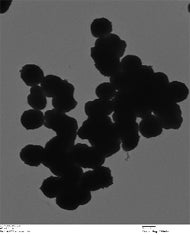Background
Despite great progress and technological innovation in the water treatment field over the past century, many challenges remain. For example, the persistence of various organic chemical pollutants such as polychlorinated biphenyls, pharmaceuticals, endocrine inhibitors, pesticides, solvents, and other toxins in treated water and the environment is an ongoing concern in water treatment. Furthermore, pathogens such as Cryptosporidium parvum and Mycobacterium avium are recalcitrant to chlorine-based water disinfection technology, forcing reliance on expensive alternative treatment technologies such as UV light or ozone based disinfection. Nanoscale titanium dioxide (TiO2) has been extensively researched over the past decades for water treatment applications, due to its low cost and high efficiency as a photocatalyst.
Description of the invention
This technology involves the surface immobilization of TiO2 onto colloidal superparamagnetic substrate microspheres, while incorporating the latest advances in TiO2 doping and surface treatment to allow the material to be used efficiently under solar illumination. This formulation allows efficient mixing of the TiO2 with contaminated water, followed by cheap, fast, and simple magnetic recycling of the catalyst. In this manner, these particles could be used continually for water decontamination, with sunlight as the only necessary input. The figure on top left of the page, shows a transmission electron micrograph of the composite microparticles consisting of superparamagnetic core particles, coated with an electrically insulating layer of silicon dioxide, coated with a surface layer of titanium dioxide.
Advantages
This technology intends to address the traditional challenges TiO2 has faced in moving to practical applications, including poor efficiency when used in sunlight, and difficult particle recovery when used in slurry-type reactors, while applying the latest advances in TiO2 nanoparticle synthesis to ensure maximal photocatalytic efficiency. As these nanoparticles can operate under sunlight and be magnetically recycled, it is anticipated to have minimal operational costs to be associated with their use in water treatment applications
Potential applications
- Water treatment
- Magnetic separation
- Photocatalysis
- Nanotechnology, titanium dioxide, antimicrobial

Close-up of microparticles
Reference
8810-7314
Inventors
Dr. Frank Gu
Tim Leshuk
Stuart Linley
Dept. Chemical Engineering, Waterloo
Patent status
PCT, U.S., and Canadian patent applications filed
Stage of development
Prototype stage, seeking ongoing collaboration with an industrial partner